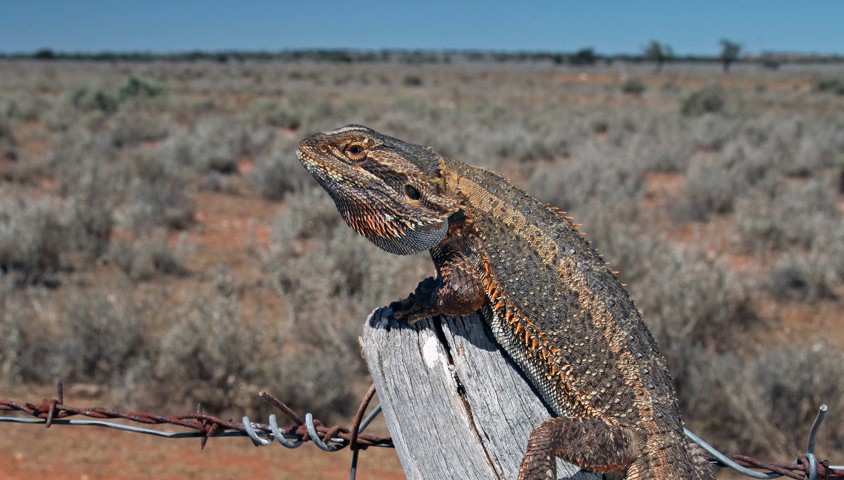Distributed throughout central Australia, the bearded dragon (Pogona vitticeps) is known to be able to alter its colouration from creamy-golden, nearly orange tones, to dark brown and black in order to camouflage, and also as a signal to other dragons.
Recent research led by scientists at the University of Melbourne found that wild-caught dragons changed colour on their backs in response to changes in ambient temperature, while regions on the lizards’ chest and beard didn’t change as a result of temperature, but rather during social displays.
The report’s lead author Kathleen Smith, a Masters student from The University of Melbourne, travelled to Walpeup in northwest Victoria in order to capture 12 male dragons during the breeding season.
“We chose to work with wild-caught specimens so that we could observe their behaviour in the lab as well as in the wild,” Smith told Wild in a recent interview. “We also know that males tend to show the greatest colour change during social displays, so we specifically sampled for them.”
As in many other species that can change colour at will, the skin of bearded dragons contain many specialised cells, called chromatophores, which are able to rapidly change the density of pigment molecules within the cell, thereby changing the overall colour of the lizard’s skin.
Species of octopus and chameleon, among others, use this capability primarily for camouflage or display, while Smith and the other scientists researching dragons had a particular interest in how they might react to temperature.
“Dragons have been observed to change colour according to their circadian rhythm,” Smith said. “When they go to sleep they’re generally a lighter colour and they appear darkest just prior to waking up. As the sun gets stronger they tend to go light again. We wanted to see to what extent this might be linked to thermoregulation.”
In a temperature-controlled environment, the lizards were observed at 15oC and 40oC, representing the upper and lower extremes in temperature the lizards would naturally face.
The lizards were observed for a period of time under these conditions, with any changes in colour measured by spectrometer and with photographs being taken throughout.
“We found the bearded dragons changed colour according to the temperature they were exposed to, but only on their dorsal surfaces,” Smith said. “Further experiments in which we paired the dragons in sight of each other resulted in colour changes on their beard and ventral surfaces. Our results suggest that the lizards change colour on different parts of their bodies for different reasons.”
As well as confirming these observations with the lizards after they’d been released, Smith and the research team also developed a series of biophysical models to try and gain insight into the effectiveness of the lizards’ changing colour for thermoregulation.
“We had measured the changes in the lizard’s skin reflectance and could therefore estimate how quickly they would warm up. We found the bearded dragons could save around 22 minutes of basking time each day using this ability, thereby saving up to 85 hours over the breeding season for more foraging and mating activities.”
The research may help scientists and conservationists gain a better understanding of how bearded dragons might cope with future changes to ambient temperatures.
The resulting paper, published in Proceedings of the Royal Society B, concludes that, ‘colour change may serve an important thermoregulatory function and that partitioning colour change on different body regions may be a mechanism to accommodate conflicting requirements of thermoregulation and signalling’.
While having only observed lizards from one population in Victoria, Smith said she’s hopeful her research can be expanded to see if there are differences to be found in other populations of bearded dragons.



